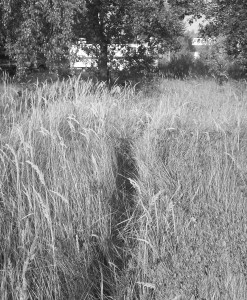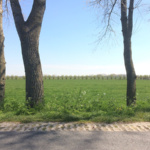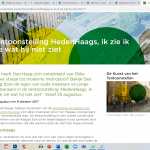'Making Dutch Space – a morphology of the idea of makeability. It is the title…
Research essay
 In the twentieth century, the landscape disappeared from both painting and poetry, and this was no accident, according to Lemaire. The world, in the last hundred years, has become an artificial place from which nature is gradually being eliminated. The natural landscape is the victim. Man finds himself in an environment that he himself has created and that refers only to himself. Lemaire, ‘with open senses’.
In the twentieth century, the landscape disappeared from both painting and poetry, and this was no accident, according to Lemaire. The world, in the last hundred years, has become an artificial place from which nature is gradually being eliminated. The natural landscape is the victim. Man finds himself in an environment that he himself has created and that refers only to himself. Lemaire, ‘with open senses’.
Living in the twenty-first century, we see things moving even faster towards a point where, in Jamesons’ words: “Postmodern hyperspace finally succeeds in transcending the capacities of the individual human body to locate itself, to organize its immediate surroundings perceptually, and cognitively to map its position in a mapable external world”
(See blog ‘making a space into a place’)
These developments condition the way we adults live ‘in our heads’ much more than ‘in our bodies’. Of the senses, we favor sight – and to a lesser degree: hearing – to an extra-ordinary degree, spurred on by technology that is able to represent, reproduce and multiply language, pictures and sounds but leaves the cupboard bare as far as (the representation of) sensations of taste, smell, touch and balance are concerned. This phenomenon is reflected even in language. We have a word for being without vision (blind), without hearing (deaf), and without speaking (mute), but no words for being without taste, smell, touch or balance. (See blog ‘more senses than six’)
An interesting paradox manifests itself here. Man used to be a relatively defenseless animal, depending on all the senses for early warnings of any danger. We developed technology to provide what nature has not provided us with: fur, claws, muscular strength, speed. Now when using this technology, we become alienated from the natural world. (See blog ‘mimicking a dotcom’)
In effect, we are becoming ‘Williams’ as in the short story “William and Mary” by Roald Dahl. In this story Mary’s husband William’s body dies of cancer, but his brain is saved, removed from his skull, set in a basin of cerebrospinal fluid and hooked up to life-supporting machinery. One of William’s eyes is floating on top of the fluid in a plastic case. Mary is appalled that a part of her husband is still alive and dictating commands to her. Shown William’s brain, conscious and alive in its basin, she is surprised to feel a sort of affection for him in this state. “He looks so helpless and silent laying there” she says
Developments in society are mirrored in the world of the arts. What we have seen these last decades is the birth of a tribe of nomadic artists, hopping from city to city, itinerant and without sustained contact with landscape or context. Being ‘out of place’ seems to be the new norm, a ‘must be’ for modern artists. (See blog ‘making a space into a place’)
And the art public? I want to quote American artist David Hammons here, who describes the art public’s attitude very succinctly: “The art audience is the worst audience in the world. It’s overly educated, it’s conservative, it’s out to criticize, not to understand and it never has any fun. Why should I spend my time playing to that audience? That’s like going into a lion’s den. So I refuse to deal with that audience, and I’ll play with street audience. That audience is much more human and their opinion is from the heart”. (See blog ‘never any fun’ )
The idea of ‘playing with street audience’ is, of course, an urban concept, and Hammons is an urban artist. This preference is understandable, for the city is the setting that earth’s population is moving towards. More than half the world’s population now lives in cities, and this number is rising. It is in the city that distance and alienation become forces to be reckoned with.
The science-fiction writer Asimov has foreseen and depicted extreme urbanization in his novels written in the 1950’s. A true visionary, in ‘the caves of steel’ Asimov takes urbanisation to its limit. He sites his story in a future in which all men on earth live in cities sealed off from the outside by domes of steel. All are terrified of anything outside, anything natural. Quote, page 82: “the short light gusts of air against his face felt unpleasant. Not that they were painful, but they were unpredictable. This irritated him. And it became worse. At the end of the corridor something blue became visible, and when they walked on, a powerful white light came in towards them. Baley had seen sunlight before. He’d been to a Natural Solarium once. But there a covering, protective layer of glass had surrounded him. Here, everything was open…”
It is difficult to live in a city and be grounded, connected. Urbanized life organizes itself around lines that are far removed from the ties of family, social group, neighborhood and kinship. Urbanization divides life into a public and a domestic sphere, and almost universally, men dominate the public sphere and the public debate. More often than not, women and children are connected to the home, the private sphere. Modern city life is striated along lines of economic position, age and gender. (See blog ‘urbanisation and social relations’)
Again, things are moving even further. In times of hyperspace, public space as a physical space may very well become deserted. As Asimov predicted, we will constitute social contact through systems of virtual reality, doing away with the necessity to move, travel or meet in real time. We may soon be living in and through a virtual world of our own making, narcissists wrapped up in a world in which everything refers only to ourselves. Indeed, we may already be losing the ability to explore and experience, to look hard, to feel, taste, and smell. Our bodies may be well on their way to become redundant.
Through my work, I want to explore these issues. I will experiment with the potentialities of ‘play’ to exercise our senses; to find our feet again; to counteract loss of sensibility and human contact. My experimental environments will be set in an urban context. I hope to emphasize the voices and strategies of women and children, as these are pertinent but have traditionally carried less weight.
| « Epistemic Encounters | <-- previous post | next post --> | A room for smelling mystery » |
|---|







